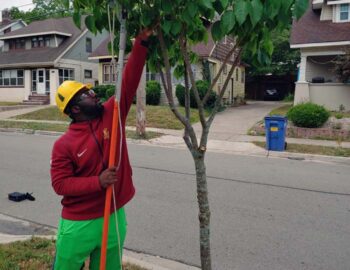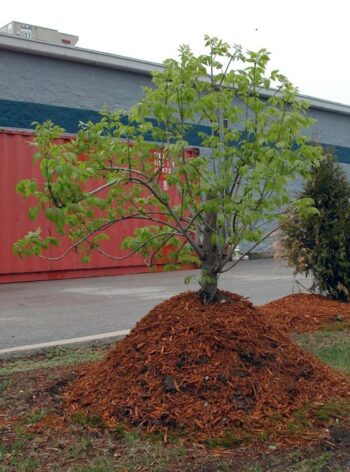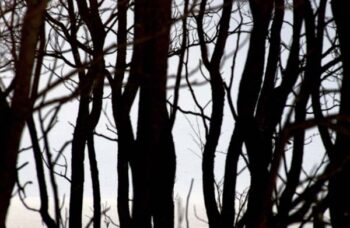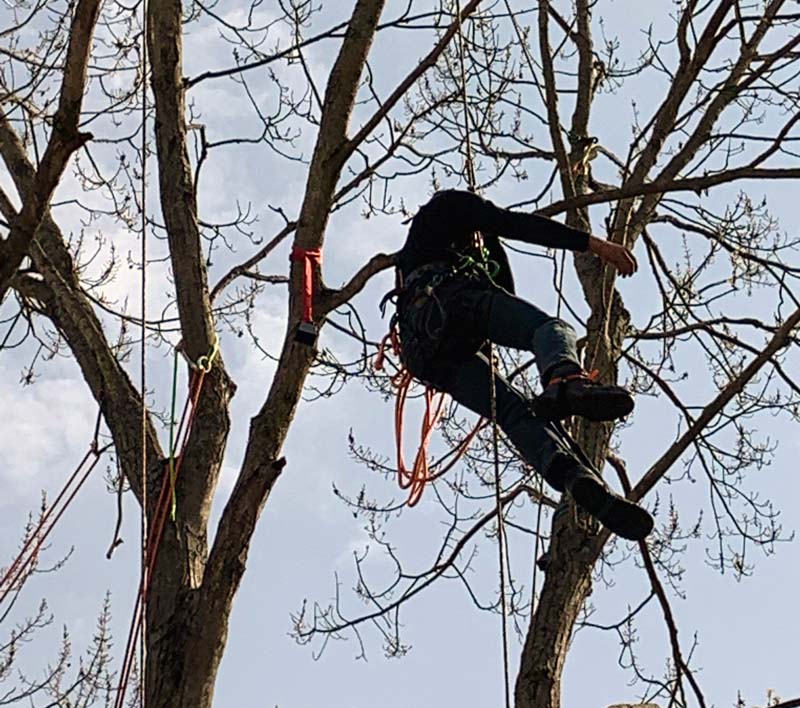By Kathleen Lavey, Michigan Department of Natural Resources
Although the trees look arty and beautiful, this also is a practical time for property owners to take a closer look and inspect their trees for problems or needed work.
“As the leaves fall off, you can start to see things that you might not be able to see in summer,” said Kevin Sayers, urban and community forestry program lead for the Michigan Department of Natural Resources. “You can see branches that are damaged, broken, hanging or even just crossing others in the tree.”
James Wieferich, a DNR forest health specialist, said it’s also easier to spot some signs of disease or insect infestation on bare trees in fall.
“Occasionally, you will see loose bark or exit holes coming out of the bark,” he said. “In many cases, exit holes are not a major concern for tree health, but some like those left behind by Asian longhorned beetles can have major implications.”
It’s also much easier to spot the creamy-to-tan egg masses laid by Lymantria dispar dispar (formerly known as gypsy moths) after leaves are down.
Pruning
Pruning can help keep trees healthy over the winter, when branches become laden with ice and snow and weak ones can break.
“Ice and snow can do pretty significant damage to any tree, but especially those that are not structurally strong or well-pruned,” Sayers said.
Look for tree branches that are damaged, broken or interfering with other branches or structures like buildings or with light fixtures. Branches that cross or touch each other or other things can get damaged or cause damage during winter storms. Then, create a plan for how to properly trim or remove them.

Remember safety first when pruning trees, especially large trees. Use the proper tools, wear gloves and safety glasses, and never trim branches near power lines or from a ladder.
Sometimes the work is best left to experts. Sayers recommends hiring a professional arborist for large trees or difficult situations. An arborist also may be able to suggest ways to preserve and care for damaged trees that might otherwise be removed unnecessarily.
“An experienced and skilled arborist may suggest cabling or bracing as a better option to pruning,” Sayers said.
In most cases, homeowners can handle ground-based pruning on smaller trees and branches with hand tools. Check out the Arbor Day Foundation’s tips and guidelines for pruning.
When tree removal is needed, it’s best to hire a professional who is certified and insured, because the work can be complicated and dangerous. Don’t risk damaging property, causing injury or worse by trying to do it yourself.
The International Society of Arboriculture has a tool for finding a certified arborist in your area, and the Tree Care Industry Association maintains a list of accredited tree-care companies.
Mulch
Mulch offers many benefits, and during a harsh winter, it can provide an important layer of insulation for tree roots.
“It acts like a blanket, helping to moderate changes in soil temperature and moisture,” Sayers said.

“Trees do need moisture, even in the winter, especially the evergreens. On those bright and sunny but cold days, evergreen trees will begin to transpire, or move water from the roots to the needles,” he said. “But if water is unavailable, they can dry out, turn red or brown and result in what’s called ‘winter burn.’”
That’s why it’s a good idea to water trees in the fall, especially newly planted trees or evergreen trees and if it has been dry.
A 2- to 3-inch layer of mulch applied under the tree canopy is usually sufficient. It’s important to keep mulch a few inches away from the tree trunk to avoid potentially trapping moisture that can lead to decay or disease. Michigan State University Extension offers mulching tips.
Leaf litter is a great form of mulch that provides organic matter and nutrients to the soil as it breaks down. So, this fall, consider putting the rake away and mowing the leaves into mulch to fertilize the soil.
“Your trees, and other beneficial insects that shelter in the leaf litter, will thank you,” Sayers said.
Keep nibbling animals at bay
Animals can also pose a winter threat to trees and shrubs.
“Deer, mice and rabbits love to munch on shrubs and trees during the winter,” Sayers said. “Deer will eat evergreen vegetation, tree buds and chew on tender branches of young trees.”
Bucks also can scar tree trunks by rubbing their antlers on young trees, especially during the fall and early winter. Damage from rabbits and mice is typically found on trunks and branches close to the ground.
If animals are a threat, you may want to consider putting tree wrap around the trunk of trees in winter. Corrugated plastic sheathing, burlap or netting can be used to protect them. MSU Extension offers tips for deer-proofing trees.
Go after insects
Lymantria dispar dispar had a big year in 2021, defoliating trees in various parts of the state. Overall numbers are expected to decrease in 2022 across the state – and you can help reduce the nuisance around your home by taking a few simple steps.
Search tree trunks and undersides of branches for egg masses, cottony sacks that are cream to light tan in color.
“Egg masses aren’t only laid on trees. They can be on anything, your house, cars, trailers, pole barns, fenceposts,” Wieferich said. “The moths usually try to find somewhere that is a little more protected from the weather and predators to increase survival success.”
Locating a few egg masses here or there is not a huge concern but finding many egg masses larger than a quarter coin in size within a small area can mean heavy defoliation next spring.
“Healthy egg masses could produce 200 to 1,000 caterpillars each,” Wieferich said.
Take a small putty knife, a firm credit card or other hard, flat object and scrape egg masses from tree bark or other surfaces. Dump them into a bucket of soapy water and let them sit for 24 to 48 hours to kill the egg masses. You also can scrape them into a burnable container and put them on a bonfire.
“If you scrape them off and just let them fall to the ground, a lot of those egg masses will still hatch just fine,” Wieferich said. “You have to do something with them to make sure they die, or your effort will have no impact on hatch success next spring.”
There also are a few other pests to watch out for this fall.
Homeowners on the west side of the state who have hemlock trees will find that the small, cottony masses produced by the hemlock woolly adelgid are best visible from this time of year through the spring. The masses, known as ovisacs, can be found on the underside of branches at the base of needles.
The balsam woolly adelgid was detected in Michigan for the first time this year in Kent County. It attaches itself to true fir trees and creates similar white ovisacs that can be found on the trunk of trees or at the base of branches next to the trunk.
People also should keep their eyes out for a couple of pests that have infested nearby states but aren’t in Michigan yet, including the Asian longhorned beetle and the spotted lanternfly.

Asian longhorned beetles prefer maple trees above other types of hardwoods, and those trees may be a good place to start. However, the insect has a large range of host trees. Look for chewed, round depressions in the bark of the tree, pencil-sized, perfectly round tree exit holes or excessive sawdust-like buildup near the base of the tree. These signs are much easier to see when leaves are on the ground.
The spotted lanternfly also feeds on a wide range of trees, with tree of heaven, maple, walnut, willow, grape vines and hops being its preferred hosts. During the summer, these insects may gather in groups on the trunks or stems of infested plants. Infested plants may ooze, weep or have a fermented odor. Lanternflies leave egg masses over the winter, similar in size and appearance to Lemantria dispar dispar egg masses, but gray in color.
If you are out and about inspecting your trees and stumble upon something that resembles any of these pests, take a closer look and take some photos. If you can, bag and freeze the specimen. Then reach out to the Michigan Department of Agriculture and Rural Development at MDA-info@Michigan.gov or 800-292-3939 to help identify the insect.
The sooner we can identify infestations in the state, the better chance there is to eradicate an infestation before it becomes a major nuisance for our trees.
“You can help prevent the next emerald ash borer or Dutch elm disease disaster by simply following the saying, ‘If you see something, say something,’” Wieferich said.
To learn more, watch a video from the Illinois Department of Natural Resources with tips for inspecting trees and proper pruning or browse the U.S. Department of Agriculture Forest Service’s library of urban forest webinars.


